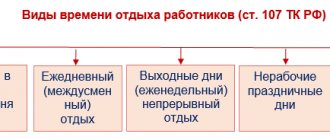Home / Labor Law / Payment and benefits / Wages
Back
Published: 03/03/2016
Reading time: 9 min
0
5966
The organization of remuneration is an important element of the work of any enterprise, and each of them has its own approaches to solving this issue. The choice of one or another remuneration system depends on many factors: the field in which the company operates, the specifics of its activities, the number of employees, etc.
The characteristics of existing payment systems (tariff and non-tariff), as well as their advantages and disadvantages, will be discussed further.
- What is a wage system
- Tariff system Main elements Tariff rate
- Salary
- Tariff coefficient
- Tariff schedule
- Floating salary system
What is a wage system
The definition of the remuneration system is contained in Art. 135 of the Labor Code of the Russian Federation, where this term refers to the set of rules for calculating wages to employees . It includes:
- establishing a relationship between the volume of labor and remuneration for it;
- specific tariff rates and official salaries;
- conditions, procedure and amounts of compensation payments;
- conditions, procedure and rules for calculating bonuses and additional payments;
- rules and procedure for calculating additional payments (vacation pay, sick leave, etc.).
At each enterprise, the employer can establish its own forms and methods of remuneration, the main condition for this is compliance with all rules and legal requirements.
The employee must receive no less than the guaranteed minimum provided by the state.
The procedure and conditions for calculating wages at an enterprise depend on what type of payment system is chosen. The two basic ones are tariff and non-tariff, but on their basis a third type arose - a mixed remuneration system. Read more about the features, advantages and disadvantages of each of them below.
Characteristic
The tariff system is a type of calculation of earnings , which is determined by the category of the specialist, the intensity and difficulty of the work performed. This type of remuneration also includes coefficients that depend on weather conditions.
An institution using the tariff option must clearly outline the wage provisions and also clearly understand what kind of system it is. When applying for a job, such a clause is fixed in the employment agreement. Failure to comply with payment rules is considered grounds for filing a lawsuit.
Considering the stability of such earnings, it is not difficult to guess who developed such a remuneration system. These are state labor protection authorities .
They were faced with the task of forming a procedure for remuneration for certain categories of workers - workers of the North, workers in hazardous industries, military personnel, medical workers, etc. Therefore, state-owned enterprises use just such a system.
The volume of the tariff is regulated by the internal documents of the enterprise.
State bodies propose to apply the same salaries for homogeneous specialties. Work of equal value must be rewarded equally (Article 22 of the Labor Code of the Russian Federation). Other additional payments in addition to the tariff can be differentiated according to qualifications, intensity and quality of work (Article 132 of the Labor Code of the Russian Federation).
Watch a video about the tariff payment system:
Tariff system
This system is basic and is used in the practical activities of most enterprises. It is a set of standards by which wages for employees are determined depending on several factors:

- complexity of the work performed;
- qualification;
- work conditions;
- nature and intensity of work;
- types of production.
Distinctive features and features of this system are:
- taking into account the contribution made to the overall result by a specific employee;
- the presence of clearly established tariff rates or official salaries, which are due to employees depending on their professional qualities;
- the ability to take into account all deviations from normal working conditions and charge appropriate additional payments for this.
Essential elements
In accordance with Art. 143 of the Labor Code of the Russian Federation, the tariff system includes the following basic elements:
Tariff rate
It determines the amount of remuneration of an employee for a certain unit of time (hour, day, month), and also takes into account the degree of complexity of the work he performs. For example, category I is established for those workers who perform the simplest actions.
A further increase in the degree of complexity of the work leads to an increase in discharge.
Tariff rates are differentiated according to the following criteria:
- labor intensity;
- type of company financing (commercial, budget, mixed);
- degree of harmfulness of work (normal, heavy, harmful).
This indicator is expressed in monetary units.
Salary
With its help, the amount of payment is determined for those workers whose work cannot be regulated. Also, salaries are set for certain types of employees (managers, employees and specialists).
Tariff coefficient
An indicator characterizing how much the tariff rate of a certain category exceeds the rate of the first category (taken as one). For example, if the wages of a worker of the second category are three times higher than the rate established for the first, the tariff coefficient is taken equal to 3.
Tariff schedule
It looks like a table with tariff rates and coefficients included in it. With its help, you can determine what kind of increase in wages an employee with a certain rank can expect.
The number of categories and the type of tariff scale applied depend on the specific field of activity of the enterprise.
Advantages and disadvantages
The main advantages of using the tariff system are the following factors:

- It is possible to take into account the contribution of each employee to the amount of work performed and pay for it in accordance with the effort or time spent.
- When calculating wages, the manager does not need to set the amount himself; all rates and salaries are determined by law. Therefore, you can use these figures when calculating the salary of all employees.
- For work in certain areas of activity or if it is performed overtime, at night, or in the form of part-time work, this system establishes clear amounts of additional payments and compensation.
However, there are also disadvantages to its implementation:
- when paying for labor, little consideration is given to the quality of the work performed; only quantitative indicators (output, hours, working days) and employee characteristics (qualifications, position) are taken into account;
- very low opportunities are created for encouraging individual employees and their material motivation to improve their work;
- Tariff rates and salaries are low and must be set in accordance with various legislative acts, which requires good knowledge of them.
Varieties
The tariff system can be used for workers in all fields of activity - it is basic for budgetary and commercial organizations, for manufacturing enterprises and companies providing various services.
This is due to the fact that with its help it is easiest to establish the level of remuneration of an employee depending on his qualifications, experience, professionalism and time spent. The tariff system takes into account the results of the work of a particular employee and is also divided into several forms:

- Piecework – in this case, payment for an employee’s work is carried out on the basis of his actual output. This form is best used in cases where the employee’s work results can be easily assessed in quantitative terms (for example, sales volumes, number of parts manufactured or customers served, etc.).
- Time-based – this form involves paying an employee based on the time actually worked. It is used in cases where it is difficult to express the labor result in quantitative terms (this includes all office workers and administrative personnel).
Each of these forms is divided into its own subspecies. The choice of one form or another depends on the specifics of the activities of a particular company.
Tariff-free system
This system provides for payment of an employee not in accordance with his individual achievements, but on the basis of an assessment of the work of the entire team. Moreover, this can be either an enterprise as a whole or small groups, departments or teams within it. There is no fixed salary or tariff rate for the employee.
In a non-tariff system, each employee is assigned a separate labor participation coefficient (LFC), on the basis of which his salary is calculated. This coefficient is multiplied by the total wage fund established for the labor group, and thus the final wage is calculated.
The features of this system are:
- Lack of established salaries and tariff rates. Their size, the amount of bonuses and other payments, as well as the procedure for their distribution are determined by the management of the enterprise. They are fixed in the local regulations of the company.
- The size of the coefficient assigned to an employee depends on many factors: his education, work experience, qualifications, work skills, etc. This indicator can be either constant or variable (that is, after a certain period of time it is revised).
- The wage fund represents a certain percentage of the total revenue or profit that the enterprise receives.
The main advantage of the non-tariff system is the high level of motivation of employees and the formation of their interest in the overall results of the company (department, group, team).
Such a system allows you to protect wages from the influence of inflation and eliminates the need for constant revision of their size.
As for the disadvantages, the main one is the fact that this system will be effective only if all employees are interested in the work and fair calculation of coefficients. Another disadvantage is the instability of wages, which depends on the level of income (in the event of a crisis, it may decrease).
It is best to use this system in enterprises with a small number of employees or in those where it is possible to divide them into groups according to functional characteristics. A tariff-free system will be effective in enterprises with a group labor organization, in which the final result is important.
What to do if the employer does not pay wages? We have compiled effective instructions for you that will work on your boss. If you are faced with an annoying delay in your salary, then know that in addition to the due wages, you are also entitled to compensation. Read more in this article.
All useful and relevant information about piecework payment is here.
Mixed system
Its peculiarity is the fact that it combines the features of both tariff and non-tariff systems. This system is very popular in many modern enterprises. Its individual subspecies are:
Floating salary system
It can be used to pay administrative employees working in a specific area. In this case, the salary will depend on the results of his activities or the level of implementation of the plan. Read more about this form of payment here.
Commission system
Most often used by trade enterprises and shops. Under this system, wages consist of two components:
- basic salary;
- percentage of revenue received from sales of company products.
If sales volume increases, wages will increase; if sales volume decreases, wages will decrease. Read more about this form of payment here.
Dealer system
In this case, the employee purchases a certain set of goods from the company and sells them independently. The salary will be determined as the difference between their costs.
Accruals according to the rate
Tariff systems are used in many modern enterprises. In accordance with the provisions of Art. 143 of the Labor Code, such models are based on the differentiation of workers into various categories. The tariff system provides:
- Rates.
- Salaries.
- Grid.
- Odds.
The main forms of this system are piecework and time-based schemes. These models are expressly provided for in legislation. The remaining schemes are not established in the standards. But according to Art. 135 of the Labor Code, the employer has the right to create in his company any accrual schemes that do not contradict the law.







